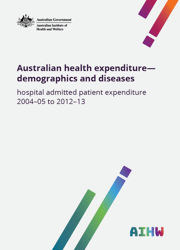Summary
There is substantial demand for information about the nature and drivers of health expenditure. In this context, the Australian Institute of Health and Welfare (AIHW) has prepared new estimates of expenditure on admitted patient care in Australia’s hospitals, providing details about expenditure for different demographic groups in the population, and expenditure related to different disease groups. The information complements the overall health expenditure information in the AIHW’s regular Health expenditure Australia reports.
The basis of the information is a new data set that provides an estimate of expenditure associated with every admitted patient separation from public and private hospitals, for the period 2004–05 to 2012–13. The purpose of this report is to outline the methods used to develop this data set and to highlight the key trends in the data.
Overall trends
In 2012–13, hospital admitted patient expenditure was estimated at $45.0 billion, and accounted for almost one-third (31%) of total health expenditure. This was $14.1 billion higher (in real terms) than in 2004–05, representing a 45.5% growth over the 9-year period. Both unit cost and volume factors played a role in this growth; however, volume was a much greater contributor.
Demographics
In 2012–13, admitted patient expenditure was highest in older age groups, with the highest in the 65–69 age group. In contrast, expenditure was highest in the 75–79 age group in 2004–05. Other peaks in expenditure over the period occurred in the youngest age group (under 1) and the 30–34 age group. All age groups experienced an increase in expenditure, with increases ranging from 25.9% in the 75–79 age group to 79.8% for patients aged 95 and over. Spending per person increased for all age groups, with an average growth of 22.4% over the period. Growth in per person spending was greatest in the 35–54 age range, peaking at 39.7% for males in the 45–49 age group.
Admitted patient expenditure in 2012–13 was estimated at $21.8 billion for males and $23.2 billion for females. Male expenditure was highest for the 65–69 age group while female expenditure was highest for the 80–84 age group. Females aged 10–14 experienced the highest growth rate, whereas for males it was the 45–49 age group.
In 2012–13, admitted patient expenditure for Aboriginal and Torres Strait Islander people was estimated at $2.1 billion—$955 million higher (in real terms) than in 2004–05. This represents growth of 84.4% over the 9-year period.
Diseases
In 2012–13, the percentage of admitted patient expenditure for Cardiovascular diseases was the highest at 11.1% ($5.0 billion). The next highest was Injuries at 9.0%, then Reproductive and maternal conditions, Gastrointestinal diseases (both 7.8%) and Chronic musculoskeletal disorders (7.7%).
The disease expenditure groups that accounted for the highest proportion of admitted patient expenditure for Aboriginal and Torres Strait Islander people in 2012–13 were Mental and behavioural disorders (11.7%), Kidney and urinary diseases (10.5%) and Injuries (9.5%).
Preliminary material: Acknowledgments; Abbreviations; Symbols
1 Introduction
2 Method
- Step 1: estimating the cost of each separation
- Step 2: scaling costs to total hospital expenditure
- Step 3: assigning expenditure to diagnoses
3 Overview of findings
- Total admitted patient expenditure
- Growth in expenditure
4 Demographics
- Expenditure by age
- Expenditure by sex
- Expenditure for Aboriginal and Torres Strait Islander people
- Expenditure by geographical location
- Expenditure on children aged under 1
5 Disease expenditure groups
- Mapping ICD-10-AM to disease expenditure groups
- Expenditure by disease expenditure groups
6 Future directions
Appendixes
Appendix A: Data Quality Statement
Appendix B: Limitations of the current method
Appendix C: Comparison of the current and previous methods
Appendix D: Adjusting for Aboriginal and Torres Strait Islander under-identification
Appendix E: Mapping of ICD-10-AM codes
Appendix F: Overview of expenditure by disease classified using ICD-10-AM
Appendix G: Hospital admitted patient expenditure tables
End matter: Glossary; References; List of tables; List of figures; Related publications



